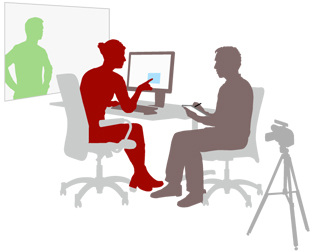 Focus Groups vs. Usability Testing
Focus Groups vs. Usability Testing
In our work with clients from a range of industries, we’ve often picked up on an understandable confusion between the definition of the terms “Focus Groups” and “Usability Testing.”
In some cases, we hear people using the two terms interchangeably, as if they have the same meaning.
This confusion is understandable because:
- Both focus groups and usability testing are user research techniques that involve assembling participants in a research setting.
- Both techniques involve gathering data from members of the target audience, not people internal to the organization requesting the research.
- And finally, both techniques are facilitated by professionals trained in research processes.
What’s important to note, however, is that the definition, goals, and timing of each technique differs quite dramatically.
Focus Groups
Focus groups are a form of user research. However, we consider focus groups as a “non-testing” form of user research.
This means that focus groups do not test how folks behave, or their performance with products. Rather, focus groups gather insight into what people say, feel, and think.
The goal of focus groups is to help companies learn about the needs, perceptions, and preferences of their customers to inform product design. Focus groups are especially valuable for learning about target audiences when an application, product or website is at the “idea stage” of product development.
For a deeper dive into focus groups, see Jakob Nielsen’s article from the archives of NN/g.
Usability Testing
Usability testing, while also a type of user research, has different goals. The purpose here is to identify problems in a user interface, or establish a baseline for measuring future improvement, or measure improvement since the last test.
In a usability test, trained facilitators observe how people actually use a product, application or website. Usability testing can be either exploratory—to discover and gain insight into problems—or validation, where more metrics are usually collected.
As the name implies, this technique resembles a traditional test environment. During usability testing, a facilitator might assign a set of tasks for users to perform as they interact with the product, application, or website. The facilitator than analyzes the test participant’s performance and experience.
The timing of usability testing in the product development cycle is important to note. Exploratory usability testing should take place as early as possible—even with paper-and-pencil prototypes—and ideally is conducted iteratively with small groups of participants. Validation testing usually takes place after a product, application, or website has been finished or is just prior to launch.
Learn More
Each of these research techniques serves an important purpose.
Focus Groups inform a company about customer perceptions. Usability Testing discovers how people interact and use a product, application, or website.
Wondering which technique best serves your project? Check out “Investing in User Research: Deciding what Research to Perform,” which summarizes a panel discussion at the Usability Professionals’ Association (UPA) International Conference.
Please contact TecEd to explore these concepts further.

